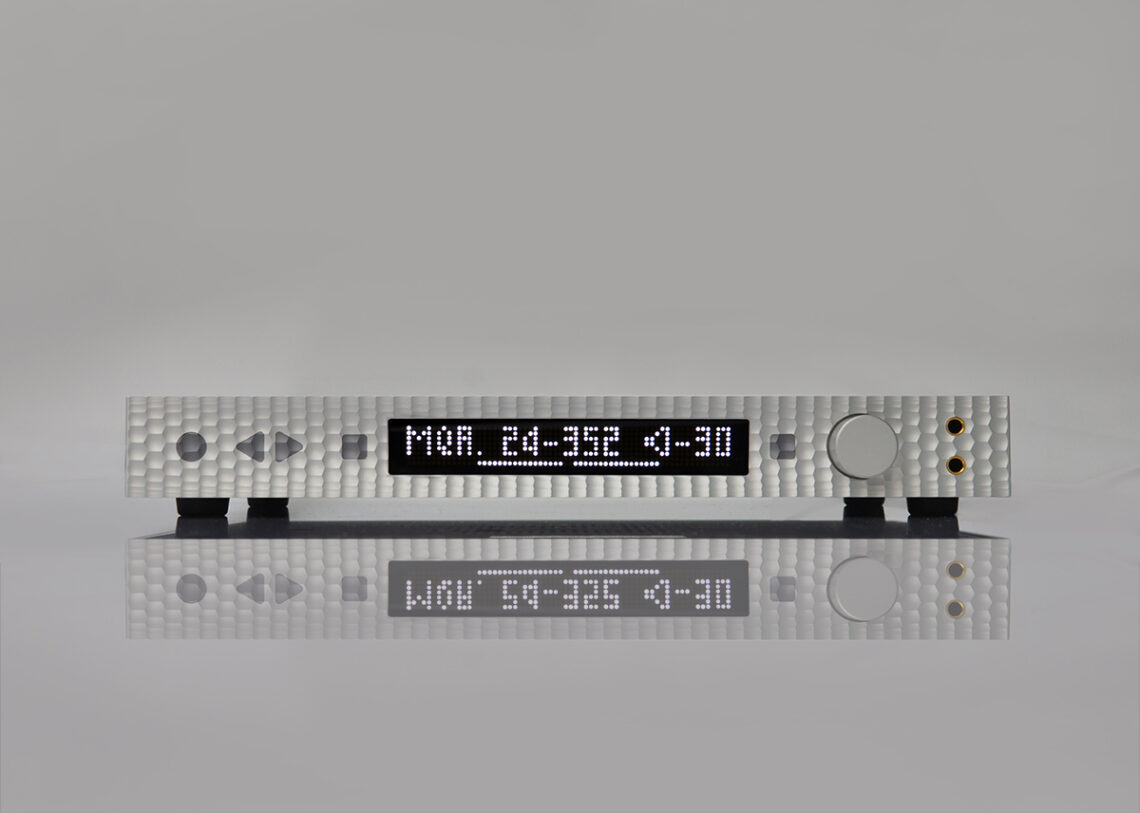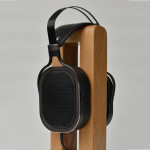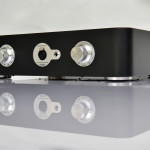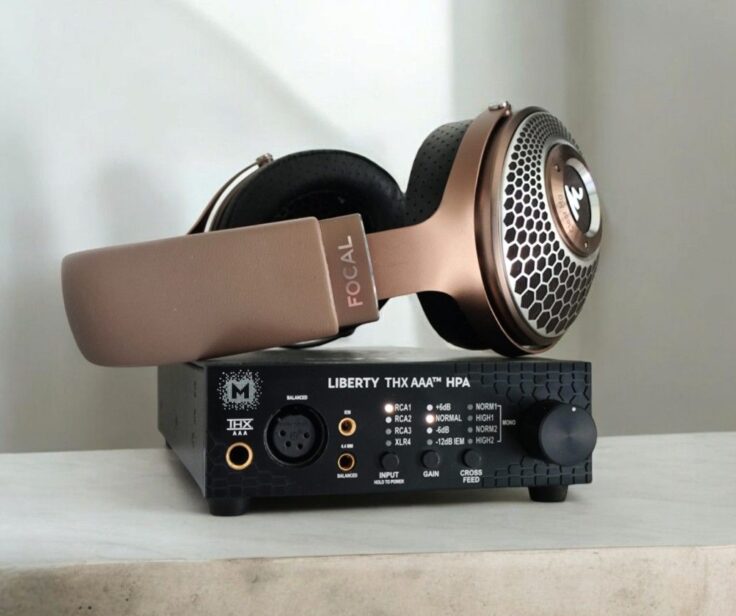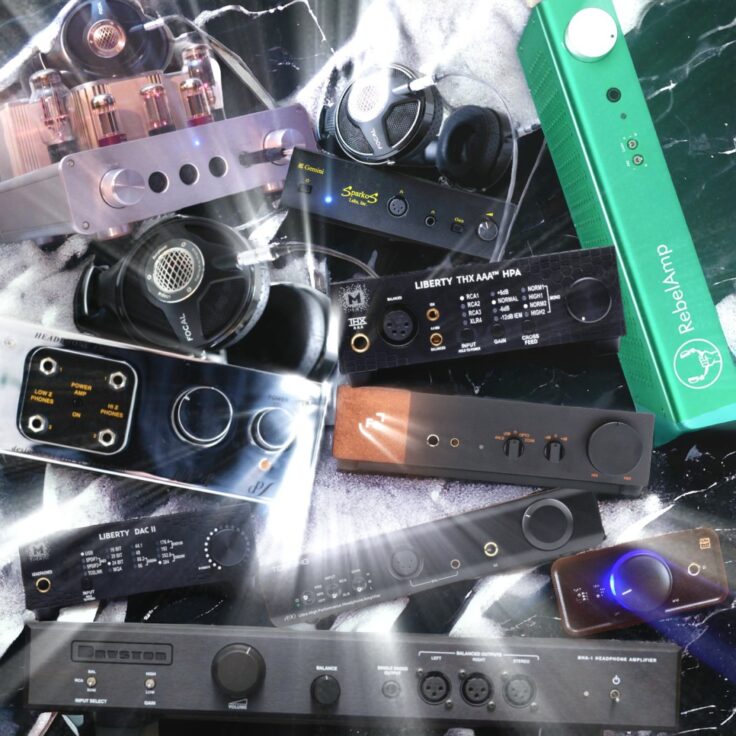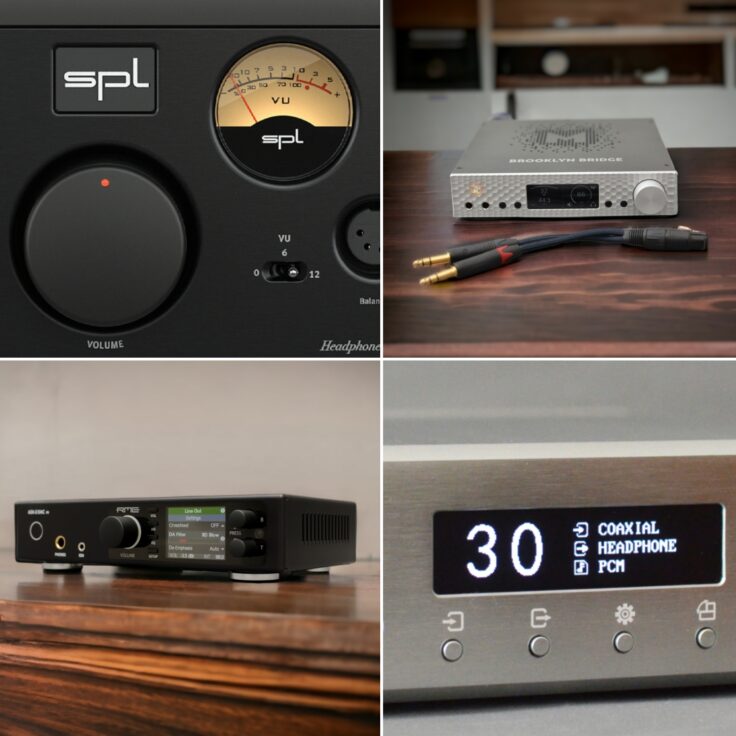The Mytek Manhattan II is the big brother of the excellent Mytek Brooklyn DAC (and DAC+), which I reviewed last year. It shares much of the massive functionality, but at more than double the price, the Manhattan II aims to be a true high-end device.
The Manhattan II is a multi talented piece of hardware: It is a DAC with a great multitude of inputs and format support (including MQA), it is a pre-amp with a user-selectable option of analog or digital volume control and it is a high-end headphone amplifier. When adding the optional network card, it becomes a fully fledged digital streamer with Roon support. You can also get a built in phono stage. The Manhattan II offers digital filters and balance control, PC/Mac connectivity for control/operation as well as digital playback and recording. The build quality is superb, the display is very handsome, and it comes with an IR remote control. All in all, this turns the Manhattan into an all in one solution for almost any scenario, just add active speakers or a power amp and a great headphone and you are fully set up.
As a headphone enthusiast, I am of course very interested in the headphone amplifier section. This review will focus quite a lot on headphone performance, but I have of course also spent some real time listening to and comparing the DAC, checking out the performance of some of the digital connectivity options (including the network card) and the pre-amplifier section.

DAC PERFORMANCE
The Manhattan II is an expensive beast ($5.9k), and for direct comparison, I soon found that the only DAC I own that was worthy of direct comparison, was my Audio-gd Master 7. The Manhattan II was easily superior to my other DACs. The Master 7 is roughly half the price, but it is also totally stripped of major (and expensive) functionality such as a volume control, analog inputs, remote controllability, optional add-on cards etc.
When I compared the Brooklyn DAC to the Master 7 in my review last year, I found the Brooklyn to perform excellently. But the two DACs were quite different (in DAC terms). I felt they both gave me lots of detail and insight but the Brooklyn was slightly crisper and drier sounding. These observations correspond to the stereotypes of the DAC chips used in the two DACs. Anyway – if I had to choose between the two only for the DAC performance, I would have chosen the Master 7. Some would call it more analog, some would call it more musical. To me, the main thing was that with the Master 7, instruments had more weight. I wrote “The Master 7 gives body to the tones, the Brooklyn exposes their brittleness”. Thus, I was curious how the Manhattan II would compare to my Master 7.
Comparing high-end DACs can be hard work. The differences are often subtle, and even if the DACs have very different internal topology, expensive DACs often sound quite similar at first listen. The reason, of course, is that all DAC designers strive for neutrality, and in expensive DACs they have gone to great lengths to compensate for the weaknesses of the chosen design and DAC chip. Comparing the Master 7 to the Manhattan II, I felt this was as true as ever.
I used several headphones and headphone amplifiers comparing the DACs. Sometimes, I couldn’t tell them apart, sometimes I did. Mostly I compared the Manhattan II using the internal network card (optional), but I also compared them running spdif from a common source.
To give an impression of how the two DACs compared, I did my usual a/b track-by-track routine with multiple setups.
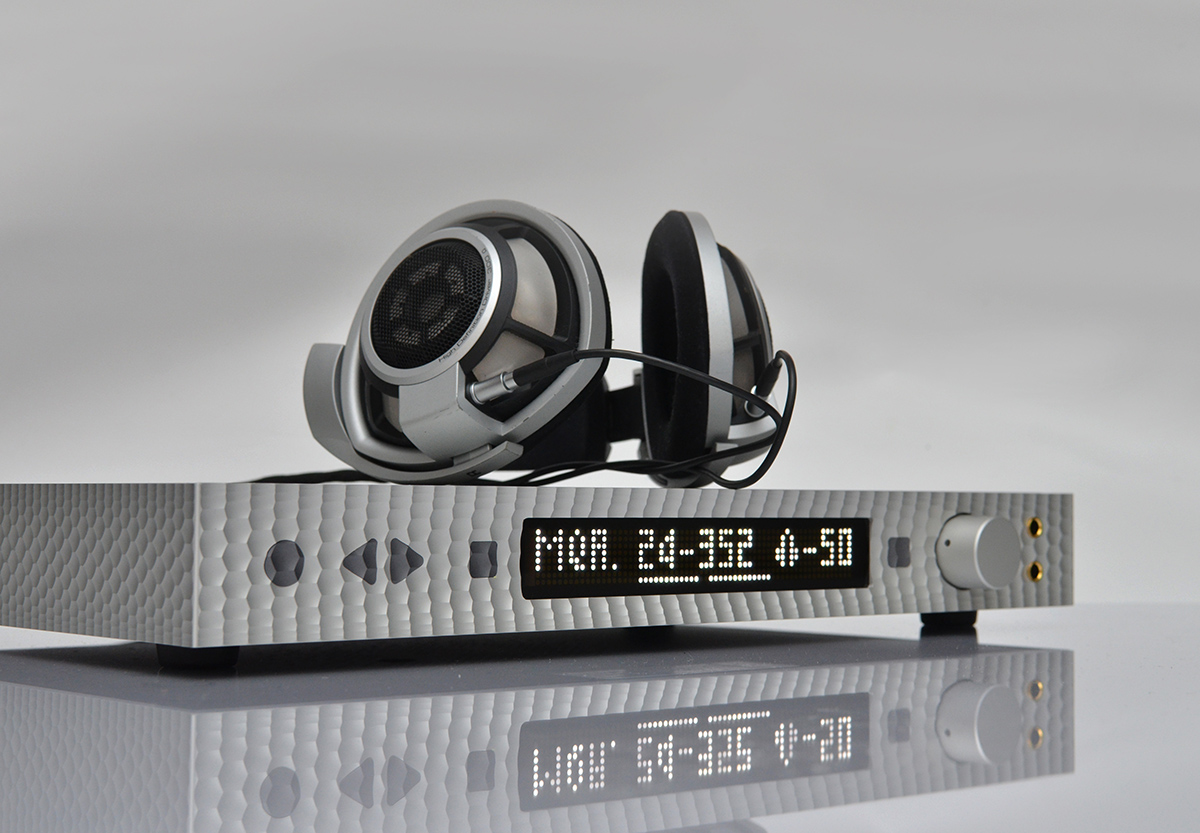
Manhattan II vs Audio-gd Master 7
Setup 1
Roon – MII Network Card/Master 7 with USB Bridge – Audio-gd Master 9 headphone amplifier – Audeze LCD-3:
Azzaharat – Eple Trio: Well behaved high-end DACs all strive for the same goal, and neither of these DACs sound very different from the other at first listen. But there is more air with the Manhattan.
Montague Grant – Prins Thomas
Again, the differences are subtle, but the Manhattan is a bit more open. They have similar tonality, the same display of musical color, but the Manhattan feels like the black is blacker.
Setup 2
Roon – Manhattan II with Network Card/Master 7 with USB Bridge – Trafomatic Head 2 headphone amplifier –
…with Beyerdynamic T1
With this setup, it is hard to tell the two DACs apart.
… with HE1000
Mi Declaration – Canturia/Frisell: The differences are subtle, but the Manhattan has an edge when it comes to clarity. I find the tonality very similar.
Violin Concerto No.4 op 31 – Mozart/Hahn: The Manhattan is a tad more textured an clean.
Faces – Tomasz Stanko: Again, the Manhattan is a bit clearer across the spectrum.
… with Hifiman HE-6
String Quartet 5 – op 18/5 Allegro – Belcea Quartet:
The strings have a bit more attack and crispness with the Manhattan, not because they are brighter but because they stand out a bit more from the background.
Tomasz Stanko – Terminal 7: The percussion is a bit more focused and a tiny tad more snappy with the Manhattan.
… with HD800
Midnight City – M83: The Manhattan is again a tad bit clearer and tighter.
Young Vivaldi – Concerto in D-minor RV813 Allegro Adagio – Modo Antiquo:: Hard to tell apart, but if anything, the Manhattan has a bit more nuance
Setup 3
Allo DigiOne – SPDIF – Manhattan II / Master 7 – Audio-gd Master 9 amplifier
… with Oppo PM-1 (balanced)
With this setup, they initially are very similar. I run through a lot of tracks, and can hardly tell the DACs apart. But sometimes I can:
Mi Declaration – Canturia/Frisell: There is more clarity to the small percussive elements in the background with the Manhattan. It is something you have to listen for, but once you hear it, it is clearly better.
For Himmerigs Land Må Man Kjempe – Flaten/Kornstad/Christensen: Again, the percussion is revealing the difference between the two. A bit more air and subtleness from the Manhattan.
… with HE-1000 (balanced)
Almost like the blues – Leonard Cohen: Small percussive elements keep being what reveals the difference between the two DACs. The space between instruments also seems a tad blacker with the Manhattan.
For Himmerigs Land Må Man Kjempe – Flaten/Kornstad/Christensen: As with the PM-1, the percussion is where I find the difference most audible. The Manhattan sounds slightly more alive.
Young Vivaldi – Concerto in D-minor RV813 Allegro Adagio – Modo Antiquo: The difference is very small, but I tend to feel that the strings have a bit more fullness with the Master 7 and a bit more nuance and texture with the Manhattan.
Setup 4
Roon – Allo DigiOne SPDIF – Manhattan II / Master 7 – Stax SRM-007tII/SR-009
The Search – Collocutor: Going between the two DACs, there is a subtle, but consistent difference. The Manhattan is perceived as a bit clearer overall.
Terminal 7 – Tomasz Stanko: Again, the Manhattan is slightly clearer sounding. But it is not very obvious, it is like two ever so slightly differently dampened listening rooms.
String Quartet No 16 F Major II – Belcea Quartet: There is slightly more clarity with the Manhattan.
Desperado – Susan Wong: The voice of Susan Wong has a softer and warmer tone with the Master 7, the Manhattan has a bit drier and slightly more textured feel to the presentation. I actually prefer the Master 7 here, but the Manhattan is more revealing.
Setup 5
Roon – Manhattan II with Network Card / Master 7 with USB Bridge – Stax SRM-007tII/SR-009
Summertime – The Head And The Heart: The female vocals are a tad thinner sounding with the Manhattan, more fleshed out with the Master 7.
Turning Point – Tord Gustavsen: The differences with this pleasant piano trio are not very big, maybe a tad more air with the Manhattan.
Merciful – Molvær: The female vocals are similarly presented here as with the earlier tracks, with the Master 7 being a tad warmer and smoother. The difference is not very big.
Dance of the Yellow Farm – Moscow Art Trio and the Norwegian Chamber Orchestra: There are lots of rattling in the background from 5:20, which is clearer with the Manhattan, the rattling is better defined in space and has more nuance.
Pick Up Sicks – Dave Brubeck: The trumpet has a little bit more flesh with the Master 7, while it feels a tad more airy with the Manhattan II.
Conclusion
In my setups, the difference between these two DACs is not big. With some setups and some music, I couldn’t tell them apart. It was easier to spot the difference between the Brooklyn and the Master 7, mainly because they had a bigger difference in tonality. But the Manhattan is consistently airier, with a blacker background and better texture, while at the same time keeping a similar level of warmth and body as the Master 7. Basically, I almost always preferred the Manhattan.
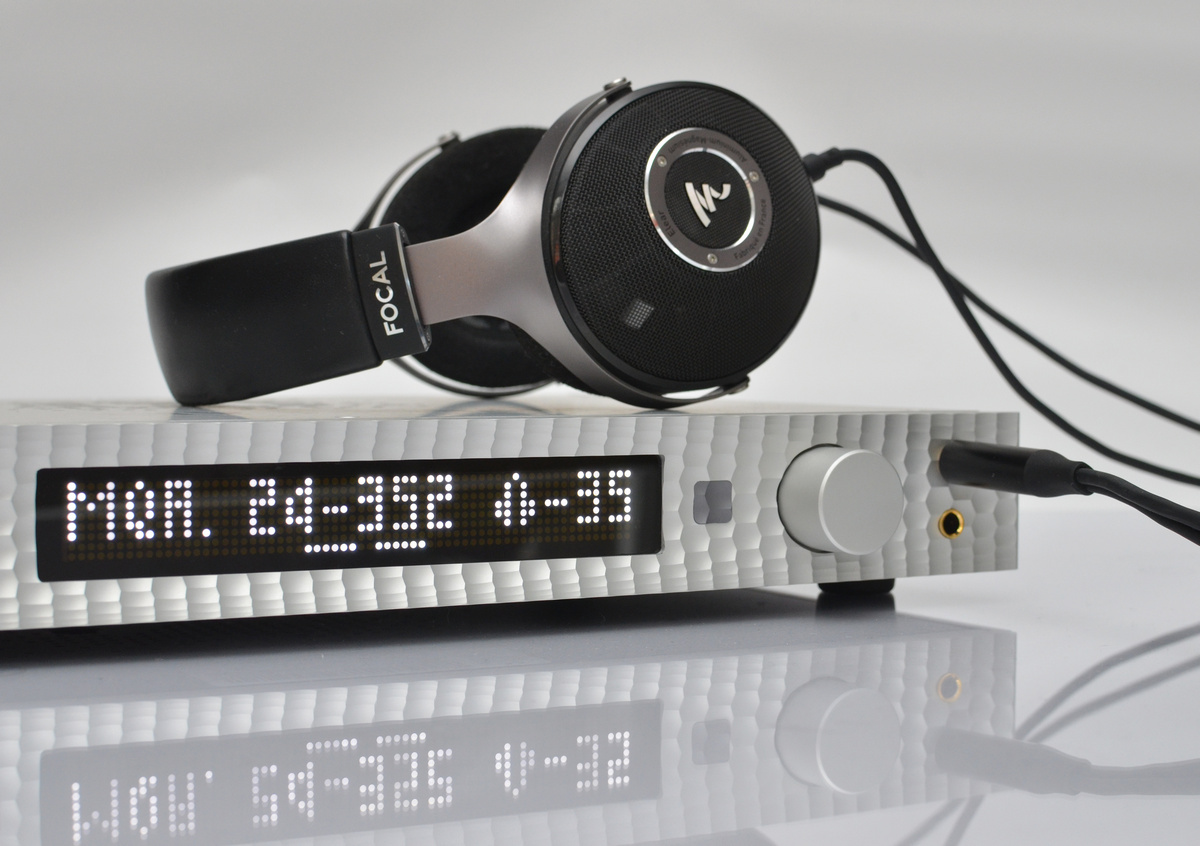
AMPLIFIER COMPARISONS
Mytek has put some serious consideration into the headphone output. To find out how successful those efforts have been, I run a range of comparisons between the Mytek and some nice sounding amps.
Mytek Manhattan II vs Moon 230HAD and Violectric V200
First, the Moon 230HAD DAC is of course not to be expected to be in the same ballpark as the three times as expensive Manhattan II. Any budget-dac will feel diffuse, unclear and probably a bit unexciting when compared to a good 5k DAC. So does the Moon 230HAD. But the Moon is here because of its headphone amplifier, along with the well known Violectric V200. I hook both up to the Manhattan’s analog outputs.
Hifiman HE-500
A fellow enthusiast told me that he was underwhelmed when hearing the Brooklyn with the HE-500 at a meet. I never tried the Brooklyn with the HE-500, but guessing the Manhattan is of similar design I was a bit curious. And sure enough – the HE-500 sounds a bit dull and muffled with the Manhattan too. It is much clearer and more fun with the Moon. The Violectric V200 is also better than the Manhattan. I would have guessed it to be a good match, but it is not. Don’t get me wrong – the Manhattan is ok, but for that price, one could expect a bit more.
LCD-2 rev.1:
Lush – Four Tet: The Manhattan is clearer, crisper and has better separation – all without sounding bright. The Moon is a bit smoother, but also more diffuse. Bringing in the Violectric V200, I find that it has more in common with the Moon, but the V200 is less pronounced in the mid-range. All in all, I find the Manhattan superior.
Close Your Eyes – Eple Trio: Same thing here. The Manhattan just does it clearer and more natural, with more space around instruments than the Moon and the V200. The Manhattan is not more detailed in a clinical or cold sounding way, just purer, with less distortion. Great dynamics too.
The Golden Age – Beck: The Manhattan feels both more detailed, natural and neutral than the V200. The Moon is similar to the V200, but with a slightly different tone.
Audio Research AR-H1
Ivy – Frank Ocean: The Manhattan feels very precise and tight, the Moon is a bit fuller. Though the Manhattan is fascinating and feels extremely detailed, I really like the warmer tonality of the Moon a lot. The V200 turns out to better them both, though – unbright, yet detailed and dynamic with great soundstage depth.
Lighthouse – Eple Trio: Again, the Manhattan feels a bit more detailed, but the Moon has better tonality, and the V200 just gets it right – to my ears and preferences. All three are good, but the Manhattan definitely is the one more prone to be accused of feeling a bit cold and clinical – but then it compensates with cleanliness.
Burn the Witch – Radiohead: This one makes preferences shift a bit. It sounds really good with the Manhattan, the Moon and the V200 are a bit dull in comparison. They are all nice, and the Moon and V200 have more of that enveloping “wall of sound” feeling, but the busyness of this track makes the Manhattan shine.
Sounds like a Sandwich – The Thing: This intense improv jazz piece sounds good on all of them, but a bit different. The Mytek is the most detailed, clean and tidy, the Moon has that nice midrange, the V200 is a bit less forward in the mids than the Moon but has a nice image depth quality.
Oppo PM-1
Chiasma – The Thing: This headphone runs very nice with the Manhattan. Great punch, warm mid-bass, lots of details and great layering. Moving on to the Moon I no longer feel the warmer tonality compensates for the lost detail, I liked the Oppo better with the Manhattan. The V200 is similar to the Moon in terms of detail but has a less forward midrange.
Bror – ingebjørg Bratland: Also here, the Moon and the V200 is a step behind the Manhattan – which finds the Oppo PM1 sweet spot. Female vocals are airy and textured, the bass is tight and full, lots of details. The other two gets a bit less dynamic and precise feeling. Nothing clinical about the Manhattan here.
I compare a bit more and the impression stands, all are good, but the Oppo PM1 is an especially great match for the Manhattan.
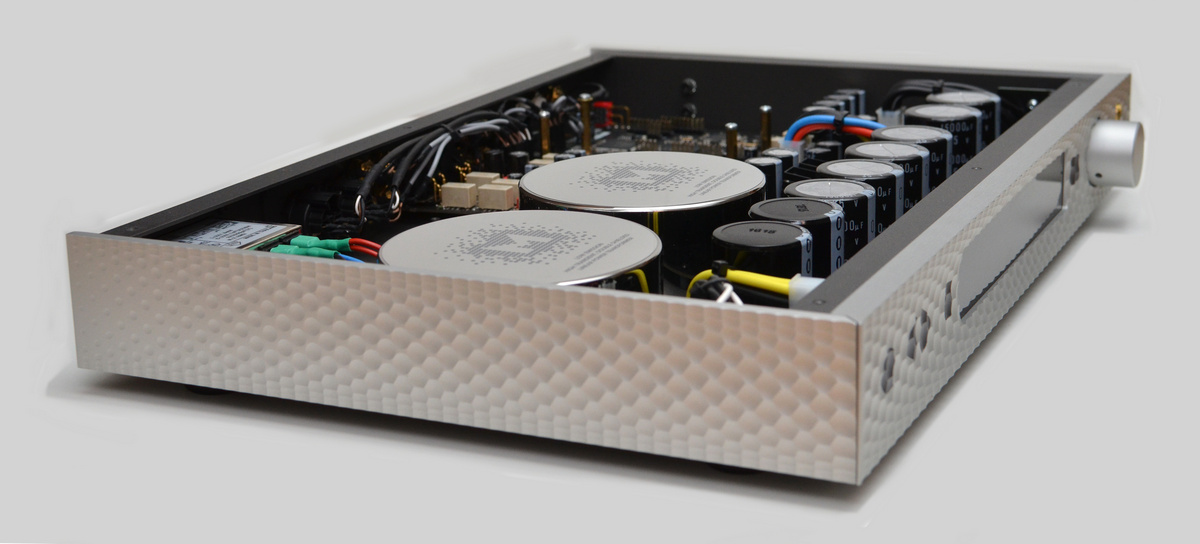
vs Questyle CMA800R
Oppo PM-1
To Leave You – Siv Jacobsen: The Manhattan continues to impress with the Oppo PM-1 on this quiet “singer-songwriter” piece with lovely female vocals. Crisp and clear, textured and nuanced with great separation and dynamics. When I switch to the CMA800R, I find the vocals less satisfying. There is less openness. The details and dynamics are in place, but I find that the Manhattan with the PM-1 just has a perfectly balanced and neutral sounding tonality.
Nattsong – Erlend Apeseth: This string dominated traditional-style instrumental is great with both, with lots of detail and great separation. But the Questyle’s slightly meatier tone suits this track well, making me prefer it here.
My Name Is Liar – Highasakite: Here too, both are great, detailed and dynamic. The Questyle a bit thicker in the tone, the Manhattan a bit thinner. I guess it is a matter of preference. The Manhattan feels more detailed, and especially when things get crowded that matters.
Digging in the Dark – Jørn Øien Trio: The Manhattan is very detailed and precise. So is the Questyle, but it has a nicer and fuller tonality. There is more meat on the bone. The Manhattan might be a tad more detailed, but the Questyle is more fun with this track.
Violin Concerto 1726, Higdon – Hilary Hahn: The Manhattan is more open sounding, more detailed. It is drier than the Questyle, but on this track in a preferable way.
Concluding – the PM-1 is a stellar match with the Manhattan. Using it with the “High” gain setting will give a slight hiss, so make sure to have it set to “Low”, which will keep the hiss away.
Audeze LCD-3
Violin Concerto 1726, Higdon – Hilary Hahn: Also with the LCD-3, the Questyle is a bit thicker/fuller sounding. But the Manhattan offers more air and subtlety. I guess it is a matter of preference and they are both really good, but I really like the Manhattan here, it is so delicate sounding.
Lost – Frank Ocean: The bass punches hard with both, but for some reason, it feels a bit more satisfying with the Questyle. It generally feels a tad warmer. I like that a bit more here, but they are both awesome.
Fostex TH-900
I´ve spent some time with the HT-900 and the Manhattan, and am really very enthusiastic about the combo. The gain switch on the back is to be set in the lowest position to avoid hiss. Once that is done it is a great experience. I’ve been listening to Eple Trio’s album “5” quite a lot lately and was starting to get a bit bored by it – but Manhattan and TH-900 had me playing it on repeat again and again.
vs Trafomatic Head 2
Focal Elear (unbalanced output)
Same Sun Same Moon – Little Hurricane: The Trafomatic has a more relaxed presentation, with a better sense of flow. But at the same time, it feels a bit laid back and lacking in aggressiveness. The Manhattan is tight and forward. The vocals are a bit less sharp with the Head 2, which also has a wider and deeper soundstage. I prefer the Head 2, but not by a large margin.
Lutoslawski PARTITA: III. Ad libitum Presto – Bård Monsen: Again, on this string and piano piece, the Manhattan is a bit more forward, the Head 2 more laid back. Both are wonderfully detailed and a good match with the Elear.
Guess I’m Doing Fine – Beck: I feel the slightly sharper tone of the Manhattan suits this track good, but the Head 2 really is still hard to beat, there is something about that soundstage.
Hifiman HE-1000 (with balanced adapter)
It’s All In Your Mind – Beck: I really like the Manhattan with the HE-1000, it brings it to life with an extra dose of crispness. With this track, I find it more engaging than the more polished presentation of the Head 2.
Lutoslawski PARTITA: III. Ad libitum Presto – Bård Monsen: The Manhattan has that extra little bite to the strings, a little more crispness, which suits the HE-1000 nicely. Again, the Head 2 shines in other ways, with a stunning three-dimensional soundstage and a more enveloping sound. Both are great.
Terminal 7 – Tomaz Stanko: The holography of the Head 2 is simply stunning here. The presentation is still a bit darker than the Manhattan, but on this track it is unbeatable. The nuances, dynamics and natural timbre is so elegantly rendered it puts a smile on my face. But then, the Manhattan also has great dynamics, holography, and timbre – and also puts a smile on my face – just not as wide.
Sennheiser HD800 (Balanced adapter)
Faces – T.Stanko: The Manhattan immediately has me tapping my foot. Lots of space between instruments, soundstage layers are easy to identify. Moving to the Head 2 things get a bit more toned down and polished. I really, really like the Head 2, but the Manhattan has a feeling of immediate clarity which makes it almost as good.
Smirenye – Zola Jesus: The tonality of the Manhattan is again a bit crisper and more direct, the Head 2 a bit darker and more enveloping.
EOS – Rostam: This beautiful little song is truly stunning on the Manhattan. It is so stunning I get a bit confused when I realize I didn’t listen to the Head 2 because the Manhattan really performs on the strengths of the Head 2. But that only shows how close the performance is, and that whatever great differences the listener observes, much of it is in the form of prejudices in the listeners head.
But going back and forth a while, I really feel the vocals have a better presence with the Manhattan.
How the West Was Won (….) – R.E.M: Both amps are extremely snappy and tactile with the drums in the opening. Great sense of space and nice layering. Typically, the vocals get a bit less forward with the Head 2, but it has an extra of that three-dimensionality.
vs Auralic Taurus
HD800 (Balanced adapter)
Electrolite – R.E.M: I feel the two amps perform quite similar, but the Manhattan seems slightly smoother, in a positive way.
Cassius – Fleet Foxes: Again, I find them similar, and the Manhattan admirable holding up against the renowned Taurus. The Manhattan feels just as detailed and spacious, but a tad smoother around the edges.
Trio in C Major, Op. 87: IV. Finale. Presto – Les Vents Francais: Also here, with the wind trio, I find the Manhattan to perform smoothly with the HD800, and in a way that makes me prefer it to the already quite great Taurus.
EOS – Rostam: There is something about the seventeen seconds that comes thirteen seconds into this song that wants me to hear it again and again. Why couldn’t Rostam have made it like one of those looping songs, like “Bitter Sweet Symphony”. Anyway – it sounds great with the Manhattan.
Hifiman HE-1000 (Balanced adapter)
Trio in C Major, Op. 87: IV. Finale. Presto – Les Vents Francais
As with the HD800, I find the Manhattan to perform better. It has a sweeter and smoother tone, without losing any details or sense of texture. The Manhattan simply sounds more refined.
How the West Was Won (….) – R.E.M: Also here, I feel the Manhattan is both more refined and dynamic.
Terminal 7 – Tomasz Stanko: The Taurus is good, but the Manhattan is more sublime, refined and clean.
Focal Elear (Unbalanced)
Violin Concerto in D Minor, RV 813: III. Allegro-Adagio – Young Vivaldi: This time, things change, and the Manhattan is the slightly less gentle and easy flowing sounding. Maybe it has something to do with the fact that I am not running balanced, but I doubt it. I still really like the Elear with the Manhattan, but this time the Taurus is even better.
Terminal 7 – Tomasz Stanko: I find the same thing here, the Taurus is a bit better.
Smlrenye – Zola Jesus: Again, the Taurus shines a little bit more.
In isolation, I always thought the Manhattan did a really good job with the Elear, but not just quite as good as the Taurus, which has a better sense of flow and ease.
Audeze LCD-3 (Balanced)
Terminal 7 – Tomasz Stanko: I always liked the LCD-3 with the Taurus. But the Manhattan is even better. Spacious and refined. The Manhattan combines the smoothness of the Taurus’ unbalanced mode with the detail and spaciousness of its balanced mode.
Azzahrat – Eple Trio: The Manhattan again has a superb combination of smoothness and detail. There are no edges that shouldn’t be there. It is really sublime with the LCD-3. The bass is powerful and dynamic.
The Search – Collocutor: The small percussion details are a tad more natural with the Manhattan, the small detail is rendered with slightly more finesse,
Beyerdynamics DT1770PRO
Agitation – Finn Peters: The Manhattan does a fine job, things are snappy and the sound is warm, full-bodied and inviting. The Taurus might be even a bit better, a slightly more open and even more snappy sounding.
Montague Grant – Prins Thomas: Here, I tend to feel the Manhattan has the upper hand. But basically, they sound quite similar.
Beethoven, String Quartet no 16 F Maj. Op.135 II Vivace, Belcea Quartet: I find them very similar.
Four Ravens – Ill Considered: Same here – both are great. If anything, I tend to favor the Manhattan.
In summary, they are both good amps for the DT1770PRO, with similar sound signature, as well as levels of detail and dynamics.
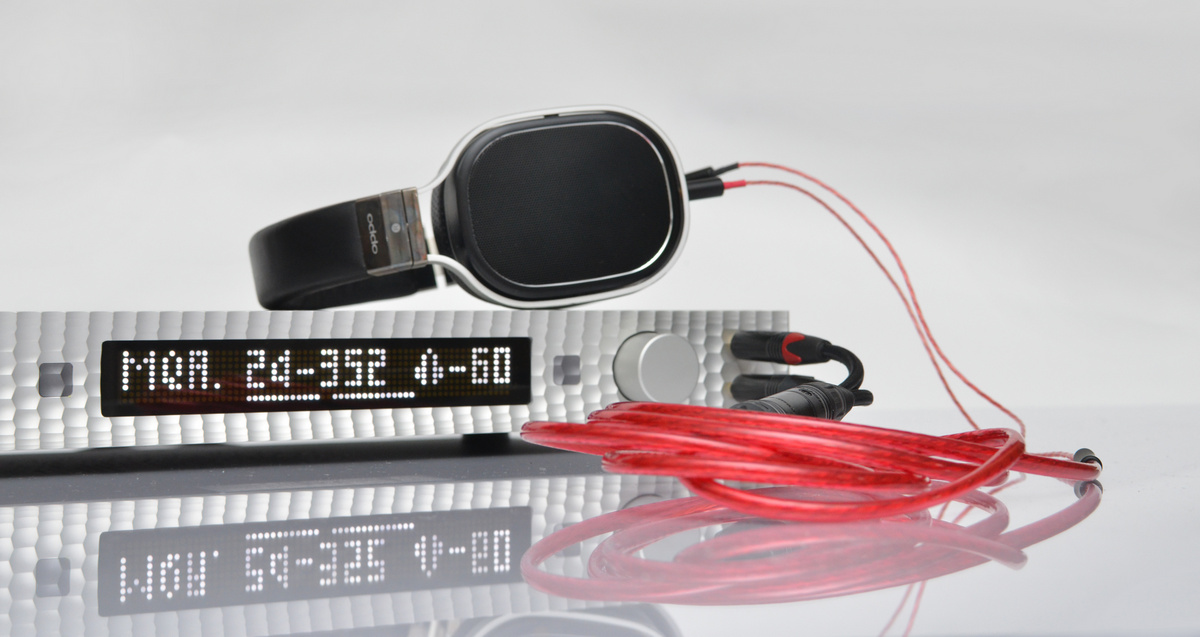
Manhattan II vs the Audio-gd Master 7/9 combo
Having tested the DAC section of the Manhattan II up against the Audio-gd 7 DAC, and the amp section of the Manhattan II against several headphone amps, I wanted to test the Manhattan II as a complete headphone setup versus another complete headphone setup: The Audio-gd Master 7 DAC / Master 9 headphone amplifier combo.
Setup remarks: The Allo DigiOne (spdif) for both. All headphones with balanced cable, using the balanced adapter for the Manhattan II.
Hifiman HE-1000
I find both setups to be a good match with the HE1000. The Manhattan sometimes feel a bit smoother, but not too smooth. And sometimes the Manhattan is a bit clearer and crisper. Mostly, they sound surprisingly similar. The differences are not big and both rigs play very well with the HE1000.
Audeze LCD-X
With the LCD-X, I tend to prefer the Audio-gd combo. It is fuller and more dynamic sounding. Playing a range of music, I tend to always like the Master 7/9 combo a bit more. Switching to the network card makes the Manhattan better, but I still prefer the Audio-gd. But I am more than content with the Manhattan II, it’s just that the Master 7/9 combo has a bit more body and feels like a better match with the LCD-X.
Audeze LCD-3
Seven Deadlies – Medeski, Martin, and Wood: The Manhattan feels a bit crisper, clearer and snappier sounding, without losing any warmth or body.
Terminal 7 – Tomasz Stanko: Here too, the Manhattan feels clearer. But the Audio-gd combo has a soothing smoothness over its presentation that almost compensates.
Smirenye – Zola Jesus: That same smoothness really comes handy with this track, which can get a bit hard on the ears.
Young Vivaldi – Concerto in D RV813 Allegro: There is more texture to the strings, more pronounced tones with the Manhattan.
All in all, I found the Manhattan played better with my LCD-3
Sennheiser HD800
Young Vivaldi – Concerto in D RV813 Allegro/Adagio: The Master combo is smoother and really likable for that reason. But others might prefer the crisper, clearer way of the Manhattan. It is hard to say one is better.
Smirenye – Zola Jesus: Coming from the LCD´s this song I really amazing with the HD800, at least soundstage-wise. And the soundstage is even more impressing with the Manhattan than with the Audio-gd stack. The amount of detail and sense of precision is impressive.
Nevermind – Leonard Cohen: Again, the Manhattan is clearer and more precise sounding.
In summary, the Manhattan really brings out some of the great qualities of the HD800.
Beyerdynamic T1 mk2
Nevermind – Leonard Cohen: The impression mimics the one I had with the HD800, the Manhattan is definitely clearer and has better control.
Dualist – Ola Kvernberg: The same thing here, the Manhattan is clearer, but the Audio-gd combo has more warmth and fullness, which weighs up a bit.
Hifiman HE-6
Sounds quite good with the Manhattan (at volume level around -25), but it is inferior to the Master 9.
Concluding – As a stand-alone headphone setup, the Manhattan II is more than capable. It is a worthy, and often superior alternative to the Audio-gd combo. The Manhattan II is an all-in-one high-end headphone setup that in my opinion defends its price tag.
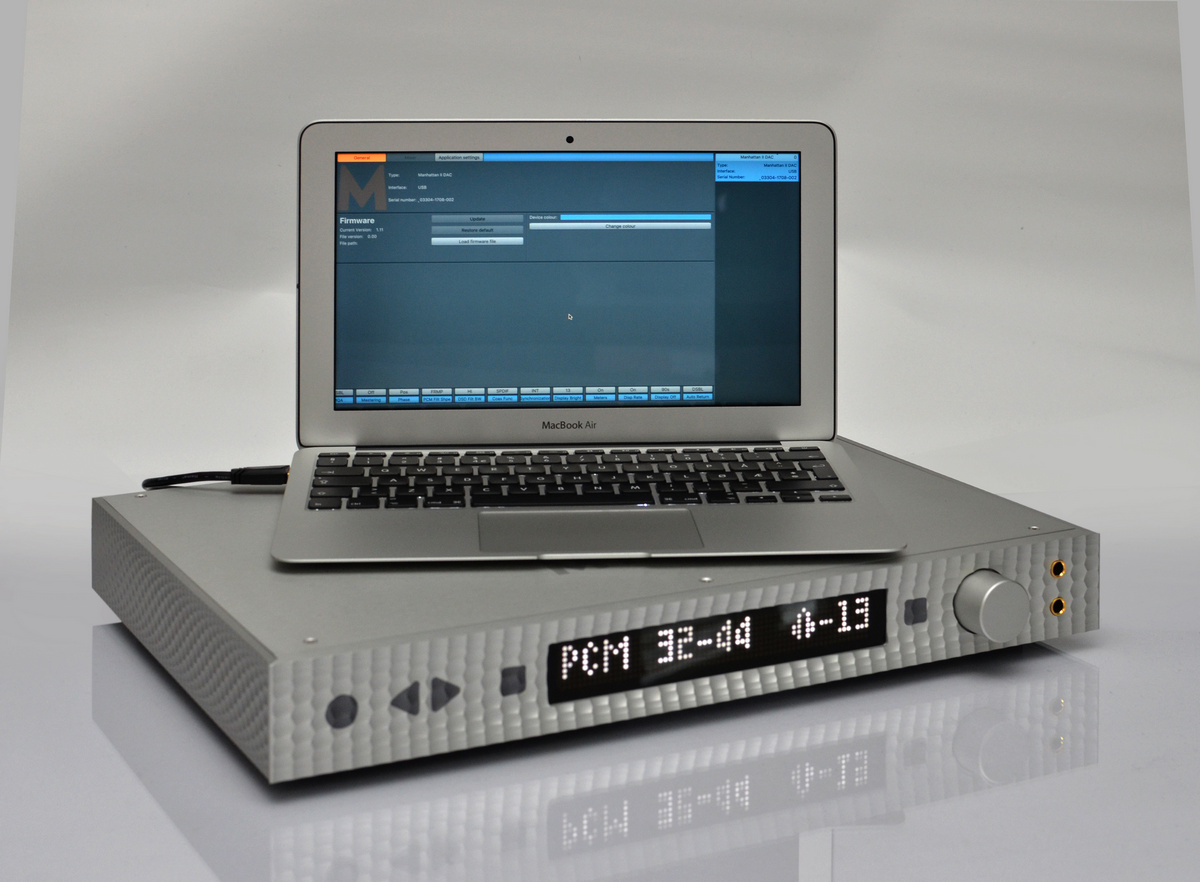
INPUTS AND OUTPUTS
One of the major selling points of the Manhattan II is its functionality and the impressive choice of inputs and outputs.
Digital Inputs
I tried out several digital sources: The Allo DigiOne SPDIF and USB Bridge digital transports, my MacBook Air, and the optional Mytek network card. Most of the time I used Roon playback software.
USB – MacBook Air
The difference is significant when comparing the Mytek network card to my MacBook Air (playing via USB using the MacOS Tidal App). Here are some examples of my listening impressions:
Igor Stravinsky DUO CONCERTANT: I. Cantilène – Monsen/Flagstad) (MQA): The instruments are clearer and more present. Not a huge difference, but it is there.
Golden Age – Beck (MQA): The guitar is crisper, more organic and alive sounding. There is more depth to the soundstage, there is a better feeling of the musical foundation.
Terminal 7 – Tomaz Stanko: The difference feels a little less obvious, but it is still there. The network card has a clearer and more full-bodied sound.
Since part of the difference could be due to software differences (I used the Mac Tidal app and compared it with Roon), I also do a test using the MacBook Air as a Roon endpoint, making it as equal as possible to the Roon Network Card. The differences turn out to be pretty identical whether I use the Tidal app or Roon with the MacBook Air:
SPDIF – Allo DigiOne
Comparing the Allo DigiOne to the Manhattan network card, I first must say that the DigiOne sounds really good. But the Network card has a tad more clarity and vibrancy. I also interestingly observe that playing MQA material via Roon to the Allo DigiOne, the Manhattan II shows that it recognizes the MQA signal via SPDIF. The display shows the same as with the USB Bridge and the network card. Actually, it goes all the way up to MQA 24/352.
Allo USB Bridge
Comparing the USB Bridge to the DIgiOne, I tend to favor the USB Bridge, but by an even smaller margin than when comparing the DigiOne to the Network card.
Comparing the Network card to the Allo USB Bridge, I find the difference very, very subtle at first listen, but must conclude that the Network card is better.
In conclusion, the Mytek Network card offers the best sound. The USB Bridge and DigiOne follow closely, but the MacBook is significantly behind. But by all means – the Manhattan still sounds great together with the MacBook.
With regards to Roon integration, they all work very well and support MQA playback, but the Network card enables you to control the volume of the Manhattan itself (not using Roon DSP) from your Roon app. This is quite a nice function. Neither the USB Bridge nor the DigiOne is able to control the Manhattan’s volume. The external sources will, however, work with a greater selection of playback software.
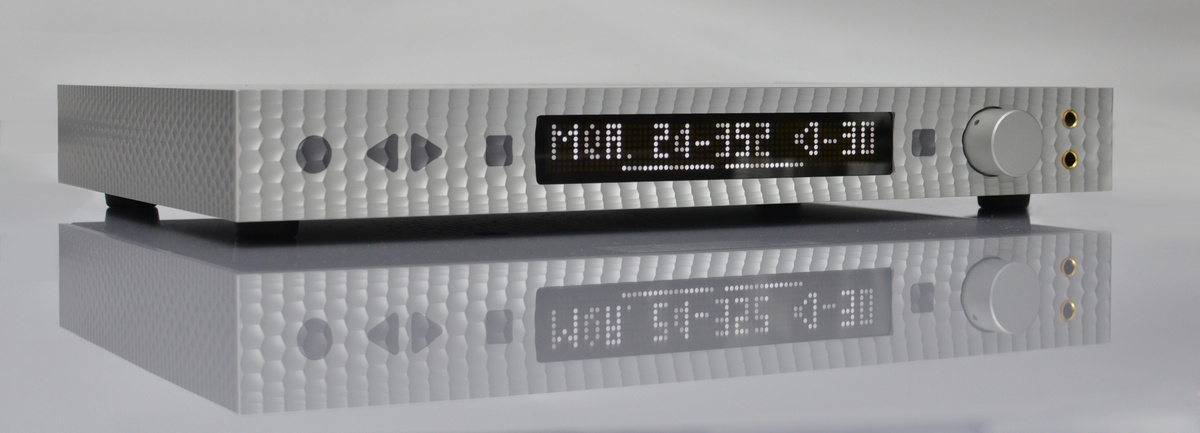
Preamp
I have no high-end dedicated pre-amps to compare the Manhattan to. But I have a selection of rather high-end headphone amplifiers. I thus compare their built-in volume control with the Manhattan’s. I do this by either setting the Manhattan to max output or setting the amplifiers volume close to max, regulating the volume with the Manhattan.
First out is the great Trafomatic Head 2. I use several headphones (HE-1000, HD800, Elear) The differences are not totally obvious, but when there is a small audible difference anything the Manhattan has the upper hand. With my Stax 007tII/SR-009 setup, I notice a definitive improvement in clarity when I use the Manhattan to adjust the volume. The same is true for the Auralic Taurus with HE-1000: Overall clarity and dynamics are improved and the music gets even more engaging.
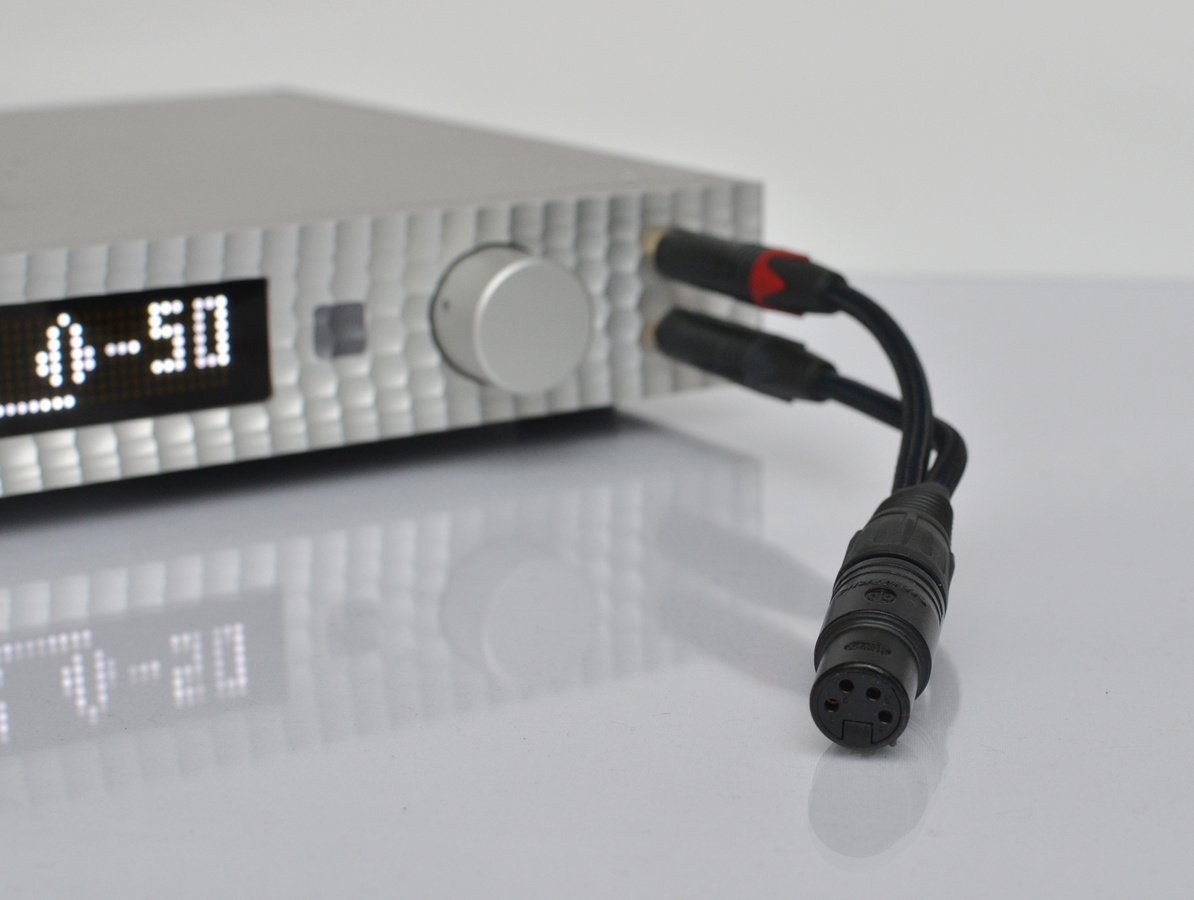
Headphone Adapter
Mytek has an optional adapter for running headphones in balanced mode, called the “Metropolis”. You can also make one yourself, using these schematics.
The adapter works because the two headphone outputs are in opposite phases. The red TRS connector should be on top, which is in phase – the black is for the lower output, which is out of phase.
I played around with it a bit and found it unsurprisingly to generally better the performance, but not always by much. If it is significant depends on the headphone. Since it increases the output power, the most obvious difference is that the output level is higher. With the HE1000 going single ended, I had to crank up the volume 5 steps. But after compensating for the level differences, I am certain the sound still feels a bit fuller and authoritative in balanced mode with the HE-1000, and I found other headphones to benefit as well. If you buy the Manhattan for demanding headphones, I’d surely recommend it. The Mytek adapter is stiff and bulky, and some would find a longer and more flexible adapter to be more practical.
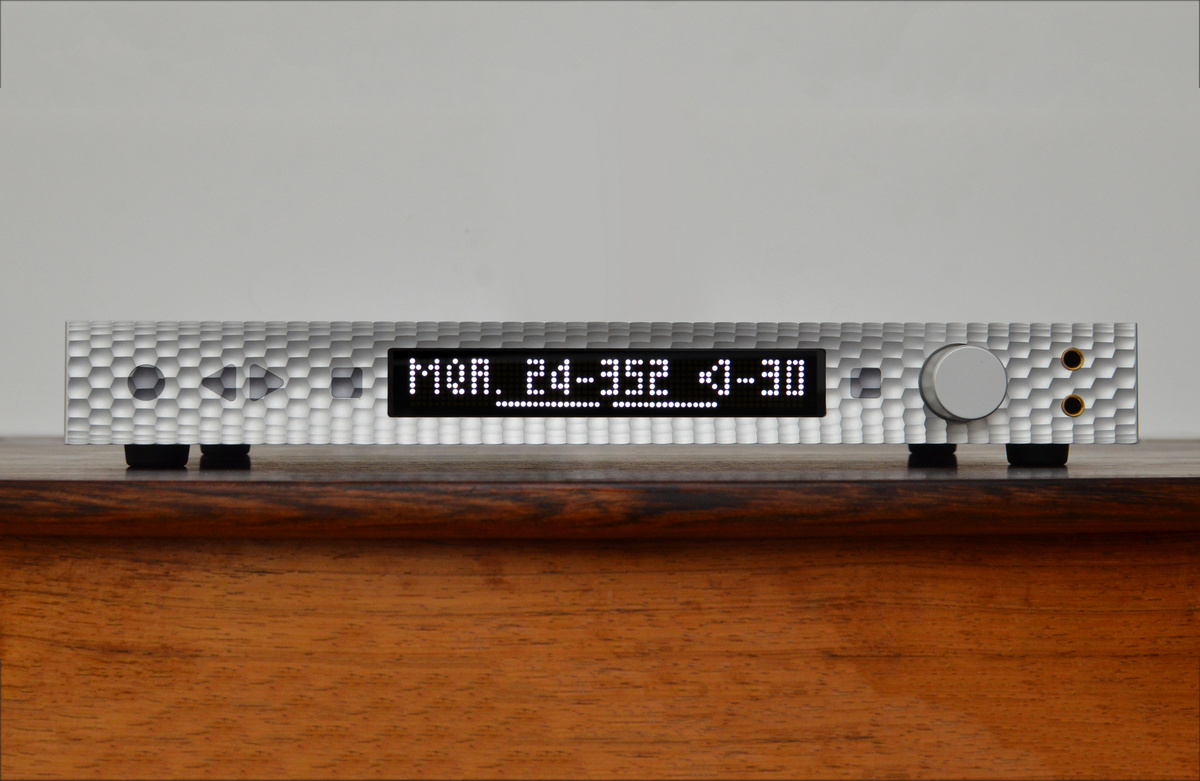
CONCLUSION
The Mytek Manhattan is the best DAC I have had in my system. It has a well-balanced sound, with warmth, body, dynamics and subtle detail. There is nothing my other DACs do that the Manhattan doesn’t do better.
As a headphone amplifier, it is really impressive, making it my favorite DAC/Headamp to date. It plays well with all my headphones (with the normal exception of the notorious HE-6) and easily competes with headphone amplifiers in the $2000 range. The preamp output is great, and the functionality is superb. The Mytek network card integrates beautifully with Roon software and also sounds better than the other digital sources I tried.
If you are looking for a complete all-in-one box for your active speakers/power amp and headphones, the Manhattan will serve you well. The price is steep, but you get a beautifully crafted product with unmatched functionality and great audio quality in all departments. If I needed a one box setup for my headphones and speakers, I could live happily with the Manhattan II.
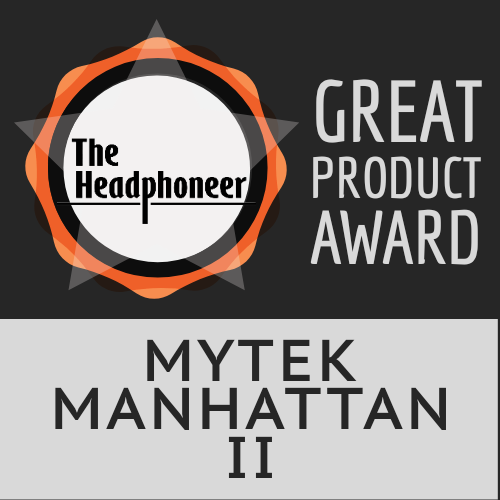
Pros
Superb DAC
Build quality and design
Functionality and flexibilty
Great pre-amp and headphone outputs
Cons
Balanced headphone output requires stiff adapter cable
If you enjoyed this article or other content on The Headphoneer, you might consider leaving a small donation to keep this website up and running. No donation is too small. Thanks for supporting us!
If you like our work please follow us on Instagram, Facebook and Twitter , it will help us grow. Sharing is caring 🙂
The review unit was lent me for the purpose of this review by Moiz Audio
Norsk importør: Moiz.no
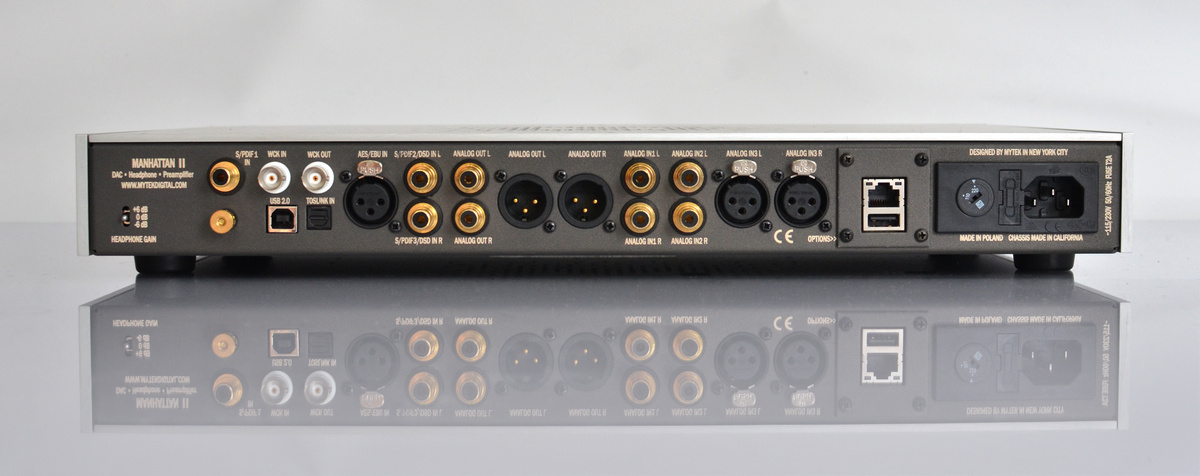
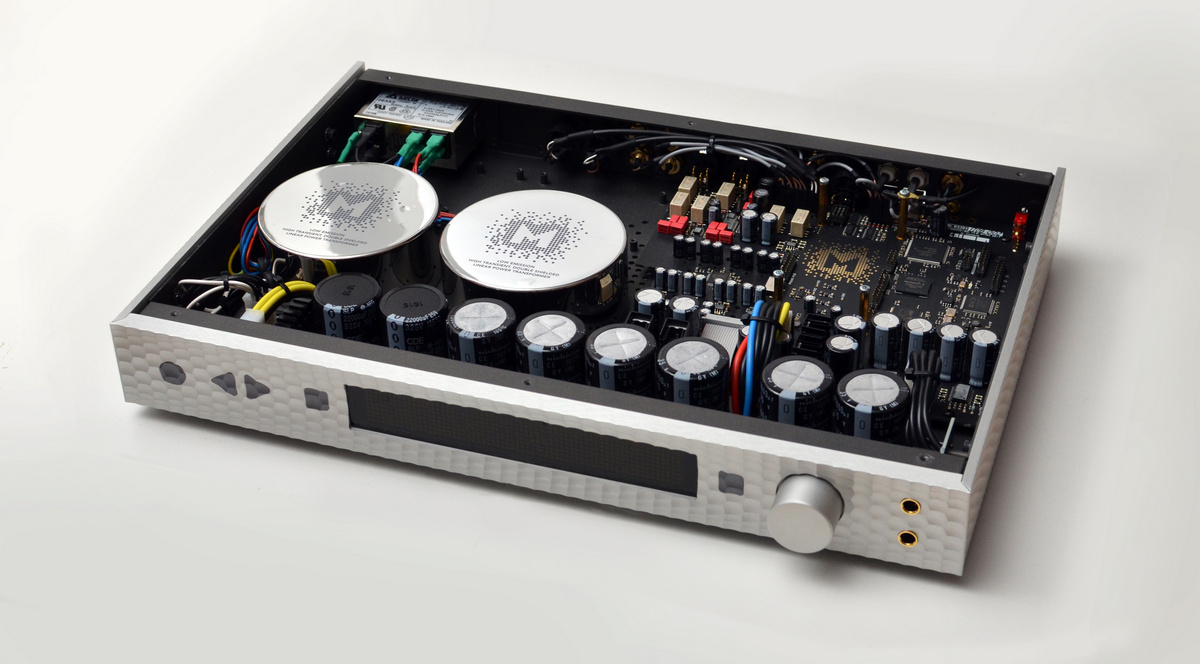
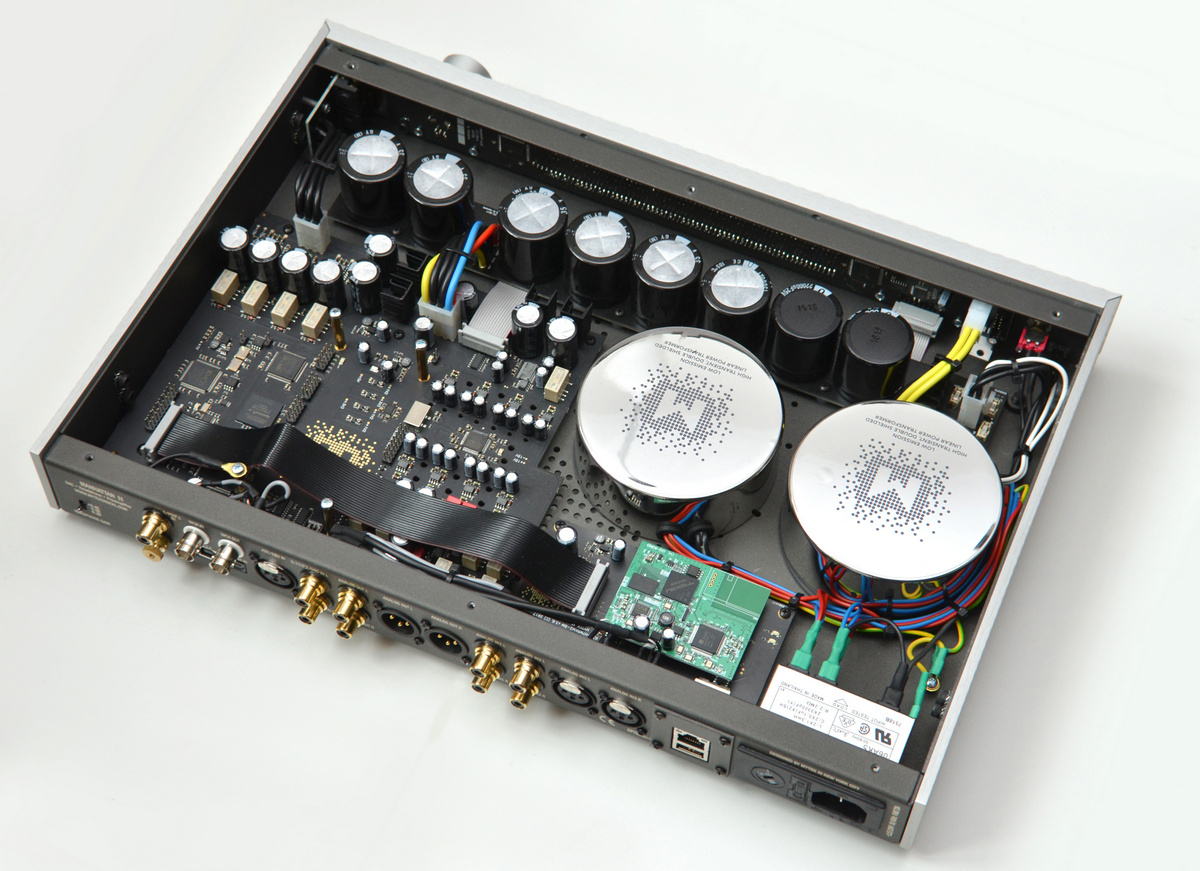
Manufacturer Specifications:
- CONVERSION: PCM up to 384k, 32bit, MQA ®, native DSD up to DSD256, DXD, 130dB Dynamic Range.
- MQA Hi-Res DECODER: built in certified hardware MQA ® decoder
- DIGITAL INPUTS: USB2 Class2 (OSX, Linux driverless, all formats), AES/EBU (PCM up to 192k, up to DSD64 DOP), 2x S/PDIF (PCM up to 192k, up to DSD64 DOP), Toslink/ADAT, 2x S/PDIF (PCM up to 192k, up to DSD64 DOP), SDIF3 DSD up to DSD256
- ANALOG INPUTS: RCA Line In switchable to Phono with Optional Phono Card insterted, second pair of RCA Line In, third pair XLR Balanced Line In.
- Analog inputs are router through minimalpath state of the art analog attenuator directly to analog and headphone outputs.
- ANALOG OUTPUTS: RCA, balanced XLR, simultaneous, 50 Ohm impedance
- HEADPHONE OUTPUTS: Reference High Current, High transient Headphone Amp, 500mA, 6 Watts, 0 Ohm out impedance. Dual headphone jacks, designed to drive demanding headphones. Balanced operation w/optional Mytek adapter.
- BUILT-IN ATTENUATOR: Choice of 1dB step analog attenuator for main out and headphones, 1dB step digital 32bit attenuator or purist relay bypass.
- CLOCK: “Mytek Femtoclock Generator ™” 0.82ps internal jitter,
- Wordclock Input and Output (allows stacking multiple units for
- multichannel operation, includes mch DSD)
- AUDIO RECORDING FUNCTION FOR DIGITAL SOURCES: All digital inputs can be routed into computer via USB2. Allows connection of external digital sources such as CD Players and digitizing ADCs.
- REMOTE: Included, universal remote capable
- FIRMWARE: Upgradable via USB Control Panel App (Win and Mac)
- OPTIONAL PRECISION PHONO ANALOG PREAMP CARD: High End M/M, M/C Phono Preamplifier with custom nickel core step up transformer , relay switchable and tunable. Input impedances, transformer ratio, RIAA curves and choice of gain can be changed within the menu or using the remote via relay switches. Optional card is sold separately and is user installable.
- OPTIONAL “ROON READY” NETWORK/Wi-Fi CARD: Turns the Manhattan II into network streamer with 24/192k andDSD64 maximum throughput. Compatible w/ Roon, Airplay, DLNA/UpnP, Spotify Connect, IOS, Android
- POWER SUPPLY: Switchable 115/230VAC (100V Japanese version available)
- DIMENSIONS: WxDxH=17″x10.5″x1.95″=432x267x50mm
- WEIGHT: 16lbs, 8kg
- WARRANTY: 2 years
Source: Mytek


